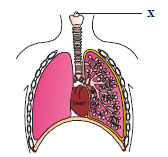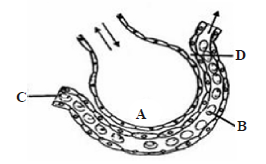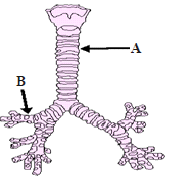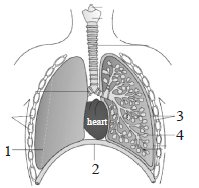Please see Chapter 17 Breathing and Exchange of Gases Exam Questions Class 11 Biology below. These important questions with solutions have been prepared based on the latest examination guidelines and syllabus issued by CBSE, NCERT, and KVS. We have provided Class 11 Biology Exam Questions and answers for all chapters in your NCERT Book for Class 11 Biology. These solved problems for The Living World in Class 11 Biology will help you to score more marks in upcoming examinations.
Exam Questions Chapter 17 Breathing and Exchange of Gases Class 11 Biology
Objective Questions
Question. Functional residual capacity can be represented as
(a) TV + ERV
(b) ERV + RV
(c) RV + IRV
(d) ERV + TV + IRV
Answer
B
Question. When 1200 mL air is left in the lungs, it is called
(a) vital capacity
(b) tidal volume
(c) residual volume
(d) inspiratory reserve volume
Answer
C
Question. In anaerobic respiration
(a) O2 is taken in.
(b) CO2is taken in.
(c) O2 is given out.
(d) CO2 is given out.
Answer
D
Question. What will be the pO2 and pCO2 in the atmospheric air as compared to that of alveolar air ?
(a) pO2 lesser and pC O2 higher
(b) pO2 higher and pCO2 lesser
(c) Both pO2 and pCO2 lesser
(d) Both pO2 and pCO2 higher
Answer
B
Question. What percentage of oxygen is carried by haemoglobin ?
(a) 90
(b) 98
(c) 23
(d) 73
Answer
B
Question. p50 value denotes
(a) percentage of oxygen
(b) partial pressure of O2
(c) percentage of haemoglobin
(d) percentage of oxyhaemoglobin
Answer
B
Question. Which of the following gases makes the most stable combination with the haemoglobin of RBCs?
(a) CO2
(b) CO
(c) O2
(d) N
Answer
B
Question. __(i)__ in CO2 in your blood, which causes __(ii)__ in pH, would cause your breathing to speed up.
(a) (i) An increase, (ii) a rise
(b) (i) An increase, (ii) a drop
(c) (i) A decrease, (ii) a rise
(d) (i) A decrease, (ii) a drop
Answer
B
Question. Dissociation of oxyhaemoglobin can be promoted by
(a) low pCO2
(b) high pCO2
(c) low body temperature
(d) high blood pH
Answer
B
Question. Residual air mostly occurs in
(a) alveoli
(b) bronchus
(c) nostrils
(d) trachea
Answer
A
Question. Asthma is caused due to
(a) infection of lungs.
(b) spasm in bronchial muscles.
(c) bleeding into pleural cavity.
(d) infection of trachea.
Answer
B
Question. Respiratory mechanism is controlled by
(a) central nervous system
(b) sympathetic nervous system
(c) parasympathetic nervous system
(d) autonomic nervous system
Answer
A
Question. The pneumotaxic centre that can moderate the function of respiratory rhythm centre is located in
(a) dorsal side of medulla
(b) ventral side of medulla
(c) aortic arch and carotid artery
(d) pons varolii
Answer
D
Question. The volume of the air that leaves the lungs in human is measured by
(a) respirometer
(b) spirometer
(c) sphygmomanometer
(d) monometer
Answer
B
Question. Which of the following group are supported by incomplete cartilaginous rings?
(a) Pharynx, primary & tertiary bronchi and initial bronchioles.
(b) Trachea, primary & secondary bronchi, and initial bronchioles.
(c) Larynx, primary, secondary and tertiary bronchi, and initial bronchioles.
(d) Trachea, primary, secondary and tertiary bronchi, and initial bronchioles.
Answer
D
Statement Type Questions
Question. Which of the following statement is correct?
(a) Tracheal rings are of hyaline cartilage .
(b) Dorsal side of thoracic chamber is formed by sternum.
(c) Expiration occurs when there is negative pressure in lungs.
(d) All of the above
Answer
A
Question. With reference to human respiration, which is correct?
(a) Pulmonary ventilation is equal to alveolar ventilation.
(b) Alveolar ventilation is more than pulmonary ventilation.
(c) Alveolar ventilation is less than pulmonary ventilation.
(d) Pulmonary ventilation is less than alveolar ventilation.
Answer
B
Question. Which one of the following statement is correct?
(a) All animals require a medium for cellular respiration.
(b) In all animals oxygen is transported by blood.
(c) All animals need oxygen for respiration.
(d) All of the above
Answer
A
Question. Identify the correct statement with reference to transport of respiratory gases by blood ?
(a) Haemoglobin is necessary for transport of carbon dioxide and carbonic anhydrase for transport of
oxygen.
(b) Haemoglobin is necessary for transport of oxygen and carbonic anhydrase for transport of carbon dioxide.
(c) Only oxygen is transported by blood.
(d) Only carbon dioxide is transported by blood.
Answer
B
Question. Mark the correct statement.
(a) Volume of residual air is higher than tidal volume.
(b) Volume of complementary air is higher than tidal volume.
(c) Volume of supplementary air is lower than residual capacity.
(d) All of the above
Answer
D
Question. Which of the following conditions is responsible for increase in ventilation rate of lungs ?
(a) Increase of CO2 content in inhaled air.
(b) Increase of CO2 content in exhaled air.
(c) Decrease in O2 content of inhaled air.
(d) Decrease in O2 content of exhaled air.
Answer
A
Question. Air travels through
(i) Nose
(ii) Skin
(iii) Trachea
(iv) Mouth
(a) Both (i) and (ii)
(b) Both (i) and (iv)
(c) only (i)
(d) only (ii)
Answer
B
Question. Read the following statements and select the correct option.
(i) Carbonic anhydrase is present in the erythrocytes .
(ii) In erythrocytes the carbon dioxide combine with water and is transported.
(a) Statement (i) is correct and is responsible for statement (ii).
(b) Statement (i) is not correct but statement (ii) is correct.
(c) Both statement (i) and (ii) are incorrect.
(d) Statement (i) is correct but not involved in statement (ii).
Answer
A
Diagram Type Questions
Question. In the given diagram of human respiratory system what is the funciton of structure marked as X ?

(a) To prevent food from entering into trachea.
(b) To filter and warm the air.
(c) To help in exchange of gases.
(d) To catch dust and bacteria.
Answer
A
Question. In which one of the options given below, the one part A, B, C or D is correctly identified along with its function?

(a) A- Alveolar cavity- It is the main site of exchange of respiratory gases.
(b) B- Red blood cell- It transports mainly carbon dioxide.
(c) C- Arterial capillary- It passes oxygen to tissues.
(d) D- Capillary wall- Here, exchange of O2 and CO2 takes place.
Answer
A
Question. In the given figure, label A represents ____________ while label B represents _________.

(a) A- Trachea, B- Bronchus
(b) A- Alveolus, B- Bronchiole
(c) A- Bronchiole, B- Trachea
(d) A- Trachea, B- Bronchiole
Answer
D
Question. The given figure shows the respiratory system. Identify the correct structure marked as 1, 2, 3 and 4 whose contraction initiated the inspiration which in turn increases the volume of thoracic chamber in the antero-posterior axis.

(a) 1-lung
(b) 2-Diaphram
(c) 3-pleural
(d) 4-Alveoli
Answer
B
Critical Thinking Type Questions
Question. Common feature in the alveoli of lungs and villi of intestine in mammals is that both
(a) provide a large surface area.
(b) have ciliated epithelium.
(c) are suited for diffusion of gases.
(d) have rich supply of blood vessels and lymph ducts.
Answer
A
Question. Presence of large number of alveoli around alveolar ducts opening into bronchioles in mammalian lungs is
(a) inefficient system of ventilation with little of residual air.
(b) inefficient system of ventilation with high percentage of residual air.
(c) an efficient system of ventilation with no residual air.
(d) an efficient system of ventilation with little residual air.
Answer
D
Question. Maximum amount of oxygen is exchanged from the blood in the ________
(a) capillaries-surrounding tissue cells.
(b) arteries of the body.
(c) left auricle of the heart.
(d) capillaries surrounding the alveoli.
Answer
A
Question. After taking a long deep breath, we do not respire for some seconds due to
(a) more CO2 in blood
(b) more O2 in blood
(c) less CO2 in blood
(d) less O2 in blood
Answer
C
Question. A large proportion of oxygen is left unused in the human blood even after its uptake by the body tissues. This O2
(a) helps in releasing more O2 to the epithelium tissues.
(b) acts as a reserve during muscular exercise.
(c) raises the pCO2 of blood to 75 mm of Hg.
(d) is enough to keep oxyhaemoglobin saturation at 96%.
Answer
B
Question. Which one of the following is a possibility for most of us in regard to breathing, by making a conscious effort?
(a) One can consciously breathe in and breathe out by moving the diaphragm alone, without moving the ribs at all.
(b) The lungs can be made fully empty by forcefully breathing out all air from them.
(c) One can breathe out air totally without oxygen.
(d) One can breathe out air through Eustachian tubes by closing both the nose and the mouth.
Answer
A
Question. The urge to inhale in humans results from
(a) rising pCO2
(b) rising pO2
(c) falling pCO2
(d) falling pO2
Answer
A
Question. The pharynx functions as a ___i___, whereas the larynx functions as a ___ii___.
(a) i- common passage for air and food; ii- passageway for food only.
(b) i- passageway for air only; ii- passageway for air and food.
(c) i- common passageway for air and food; iipassageway for air only.
(d) i- block to bacteria; ii- passage for air and food.
Answer
C
Question. In man and mammals, air passes from outside into the lungs through
(a) nasal cavity → pharynx → larynx → trachea → bronchioles → bronchi→ alveoli
(b) nasal cavity→ pharynx → larynx → trachea →bronchi → bronchioles → alveoli
(c) nasal cavity → larynx → pharynx → trachea → bronchi → alveoli
(d) nasal cavity → larynx→ pharynx → trachea → bronchioles → alveoli
Answer
B
Question. The chloride shift in red blood cells is the movement of
(a) cations into the cell to balance its uptake of chloride ions.
(b) chloride ions from the blood into the glomerular filtrate for excretion.
(c) chloride ions out of the cell to balance the release of hydrogencarbonate ions.
(d) chloride ions into the cell to balance its uptake of hydrogencarbonate ions.
Answer
C
Question. External gills, tracheae, and lungs all share which of the following sets of characteristics ?
(a) Part of gas-exchange system, exchange both CO2 and O2; increase surface area for diffusion.
(b) Used by water breathers; based on countercurrent exchange; use negative pressure breathing.
(c) Exchange only O2; are associated with a circulatory system; found in vertebrates.
(d) Found in insects; employ positive-pressure pumping based on crosscurrent flow.
Answer
A
Question. Which of the following equation shows the role of carbonic anhydrase enzyme in the transport of carbon dioxide by blood?

Answer
A